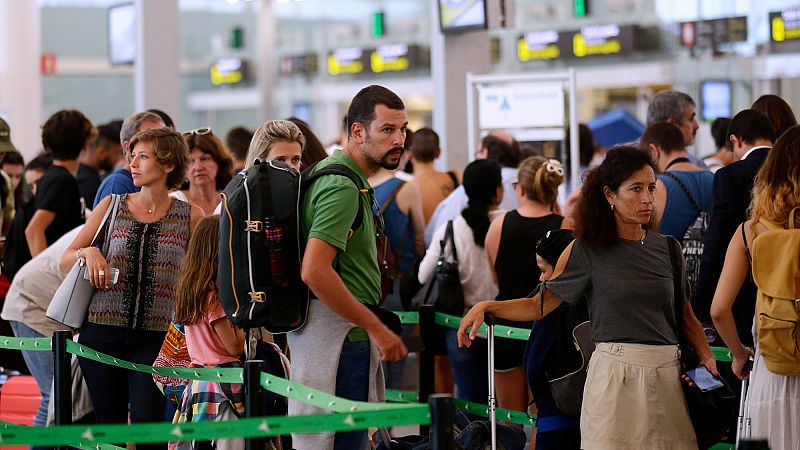EU's new Entry/Exit System launches this weekend. Here’s how travellers can prepare

The EU’s long-delayed Entry/Exit System (EES) for non-EU nationals will be phased in beginning on 12 October - this Sunday.
Travellers have expressed concerns over confusion and delays during the initial rollout period.
A survey by Holiday Extras found that 82 per cent of respondents were unclear as to how the new EES will impact trips, with 35 per cent unaware that the new rules come this weekend.
Nearly one in five holidaymakers has already changed or cancelled travel plans, with many citing worries about border delays.
If you are due to travel to the EU soon, here's how you can prepare to make the process easier.
Which countries will be the first to introduce the EES?
The EES is being introduced to bolster border security and identify travellers who overstay their permitted time in the Schengen Area (90 days within a 180-day period).
The new system requires Europe's border crossings to have dedicated infrastructure installed, a process which has proved complicated.
For this reason, from 12 October onwards, EU Member States will start introducing the EES gradually over a period of six months.
According to UK newspaper The Independent, only three countries – Estonia, Luxembourg and the Czech Republic – will have the EES in place for all arrivals and departures on Sunday.
Switzerland says the system will be in place at airports in Basel and Geneva on 12 October, while Zurich will implement it later, on 17 November.
Smaller airports, such as Lugano, Dübendorf, and Bern, will have the new system in place by the end of March 2026.
Similarly in Germany, only Düsseldorf airport will be using the EES from 12 October. Frankfurt and Munich will follow, after which other airports will also bring it in.
Spain will test the EES system on Sunday with a single flight arriving at Madrid airport, according to The Independent.
When will border checks begin for Dover, Eurostar and Eurotunnel travellers?
For travellers leaving the UK via the Port of Dover, the Eurotunnel terminal in Folkestone and the Eurostar terminal at London St Pancras, EES registration will take place upon departure, overseen by French border officials.
At both the Port of Dover and the Eurotunnel terminal, only freight and coach traffic will be subject to EES checks from Sunday.
Other traffic, including the thousands of car passengers who use the crossings each day, will be subject to the new system from 1 November.
As for Eurostar, from 12 October only business and premium class passengers will be subject to EES checks. For other passengers, they will begin in January 2026.
What does the EES mean for travellers?
At borders where the EES is in place, travellers from UK, US and other non-EU countries will need to scan their passports or other travel documents at a self-service kiosk. It will not apply to legal EU citizens or residents or those with long-stay visas.
The system will register the traveller’s name, biometric data, and the date and place of entry and exit. Facial scans and fingerprint data taken during the first registration are stored in the EES database for three years.
During this period, travellers will only need to provide a fingerprint or photo at the border when entering and exiting, which will be matched against stored data.
Will the EES cause border delays?
One of the key concerns for travellers is whether the new system will cause queues and long waiting times at borders as passengers navigate the new scanning technology.
“The concern will be, when you have flights arriving at one of these airports, at the same time, it’s already a bottleneck – this is going to add even more of an issue," Julia Lo Bue-Said, chief executive of the Advantage Travel Partnership, told the BBC.
She added that travellers should allow three to four hours to get through the new checks.
Eurostar will double the number of booths for EES launch
Cross-Channel train service Eurostar has taken precautions to ease delays at the border.
Facing overcrowding due to the limited capacity of the historic London St Pancras station, it is allowing passengers to board trains earlier.
Travellers can now take their seats 30 minutes before departure, instead of waiting in the departure lounge.
The operator says the measure will avoid additional delays for check-in, security and border checks when the EES system launches, and later for the ETIAS.
Eurostar will also double the number of border staff and manual booths.
There isn’t space for all of the new EES kiosks, up to 49 from 24, in their usual location, so they’ll be installed at various other places around the station, currently used by both domestic rail operators and the HS1 service, a high-speed railway linking London with the Channel Tunnel.
Eurostar has also assured passengers that there will be “specially-trained staff available at all times” at the new booths.
EES will be followed by ETIAS in 2026
The EES will be followed by the European Travel Information and Authorisation System (ETIAS) in late 2026, with a transitional grace period of at least six months, meaning it won’t be mandatory until 2027.
This will require non-EU travellers who don’t need a visa to obtain authorisation before entering the Schengen Area.
This will require you to complete an online application, provide personal details, answer security questions and pay a €20 fee. This authorisation will be linked to the traveller’s passport and will be valid for three years or until the passport expires.
Travellers from 60 non-EU countries will need to comply with the ETIAS, but there are some exceptions. The fee will be waived for children under 18 and adults over 70, although they will still need to apply for authorisation.
Today

